Menus
- Concept comparison on the Nordschleife
- Yamaha YZF-R6
- Kawasaki Z 900
- Suzuki GSX-S 1000
- Honda CB 1000 R.
- Compare Honda and Suzuki
- Ducati Panigale V4 S.
- BMW R 1200 S.
- KTM 790 Duke
- Triumph Street Triple 765 RS
- Affirmation of love for the Nordschleife
- Conclusion
- Data recording
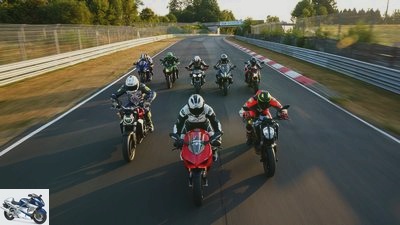
Jorg Kunstle
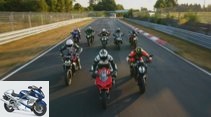
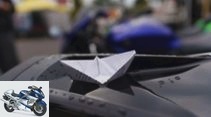

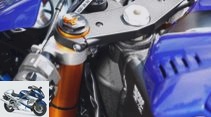
30th photos
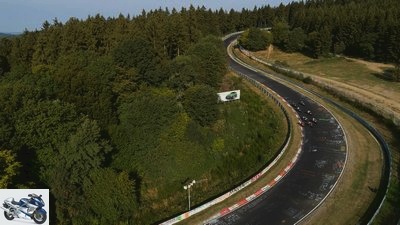
Jorg Kunstle
1/30
For the drivers, a successful lap on the Nurburgring-Nordschleife is a fulfilling experience. For the motorcycles it is pure stress. With the help of prominent guest testers, including Tim Rothig as a secret record holder, PS sent eight machines through the “Green Hell” to see whether they could pass the test. But first the motorcycles themselves have their say.
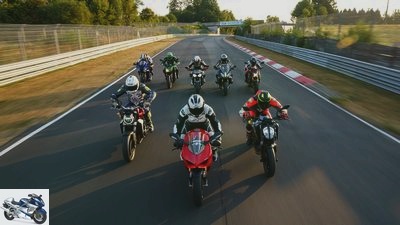
Jorg Kunstle
2/30
In comparison: BMW R 1200 RS, Ducati Panigale V4 S, Honda CB 1000 R, Kawasaki Z 900, KTM 790 Duke, Suzuki GSX-S 1000, Triumph Street Triple 765 RS and Yamaha YZF-R6.
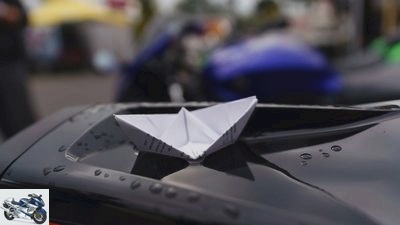
Jorg Kunstle
3/30
Sunshine and rain alternate in the Eifel more often. Rain collects on the hump of the KTM – much to the delight of the child in the man.
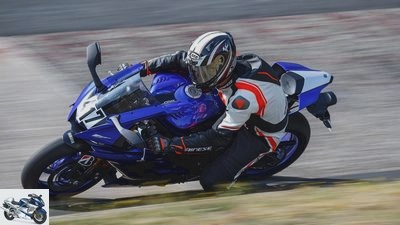
Jorg Kunstle
4/30
The technical data of the Yamaha YZF-R6 at a glance: four-cylinder in-line engine, four valves / cylinder, 119 hp at 14,500 / min, 62 Nm at 10,500 / min, displacement 599 cm³, weight 193 kg. The basic price is 13,995 euros plus additional costs.

Markus Jahn
5/30
Sturdy fork, stable steering head, tight damping – with these properties the R6 is fast, but by no means easy to drive on the Nordschleife.
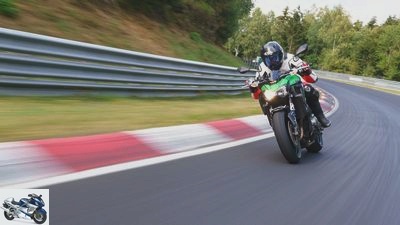
Jorg Kunstle
6/30
The technical data of the Kawasaki Z 900 at a glance: four-cylinder in-line engine, four valves / cylinder, 125 HP at 9,500 / min, 99 Nm at 7,700 / min, displacement 948 cm³, weight 212 kg. The basic price is 9,095 euros plus additional costs.
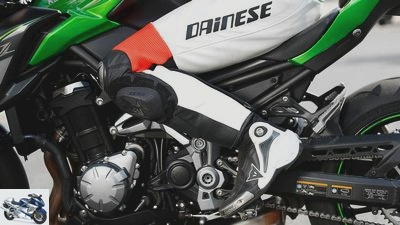
Markus Jahn
7/30
If you put your foot on the inside of the curve backwards on the peg, which is indispensable when cornering quickly, you sit at a narrow knee angle because the bench is mounted too low in relation to the foot pegs.
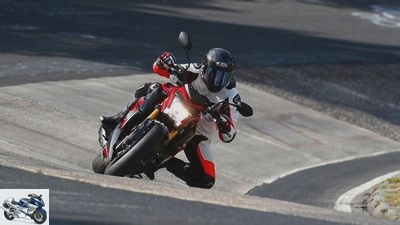
Markus Jahn
8/30
The technical data of the Suzuki GSX-S 1000 at a glance: four-cylinder in-line engine, four valves / cylinder, 150 HP at 10,000 / min, 106 Nm at 9,500 / min, displacement 999 cm³, weight 212 kg. The basic price is 12,395 euros plus additional costs.
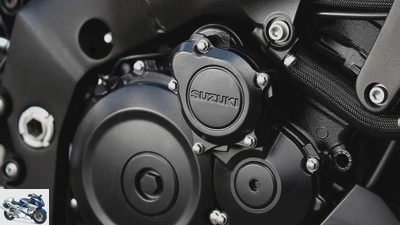
Markus Jahn
9/30
There are a few arguments in favor of this engine, primarily its performance and racing character. But why the starter gear is built directly into the lintel space behind this exposed cover remains incomprehensible.
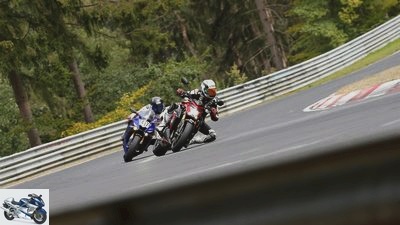
Markus Jahn
10/30
"You can actually let it run right through many blind corners: don’t lift the gas!" Ole Bartschat, PS guest tester
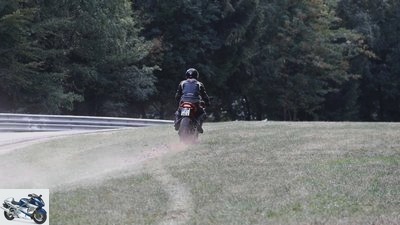
Markus Jahn
11/30
Knowledge of the route and concentration help to ideally prevent rides off the track.
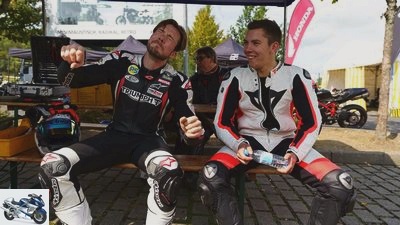
Jorg Kunstle
12/30
This can even be done "on dry land" work out.
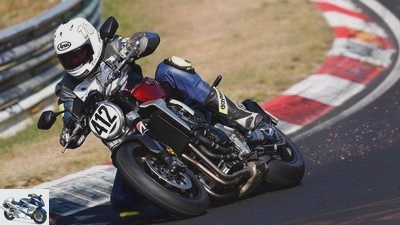
Markus Jahn
13/30
The technical data of the Honda CB 1000 R at a glance: four-cylinder in-line engine, four valves / cylinder power, 145 hp at 10,500 rpm, 104 Nm at 8,250 rpm, displacement 998 cm³, weight 214 kg. The basic price is 13,290 euros plus additional costs.
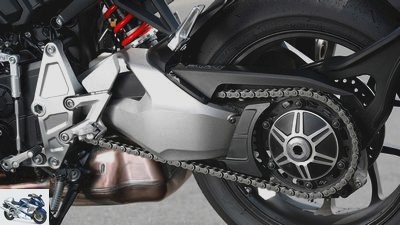
Markus Jahn
14/30
The large unsprung mass of the single-sided swing arm worsens the response of the suspension. In conjunction with the underdamped rebound stage, the rear wheel begins to trample in an inclined position and the tire loses its grip.
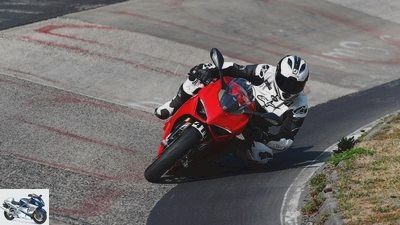
Markus Jahn
15/30
The technical data of the Ducati Panigale V4 S at a glance: four-cylinder 90-degree V-engine, four valves / cylinder, 214 hp at 13,000 / min, 124 Nm at 10,000 / min, displacement 1103 cm³, weight 201 kg. The basic price is 27,990 euros plus additional costs.
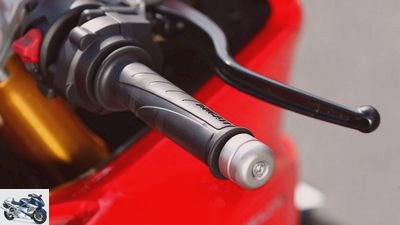
Markus Jahn
16/30
This close-up shows the most important detail of the Panigale V4 S: the throttle grip. One turn of the same accelerates the pulse and the environment in a previously unknown way.
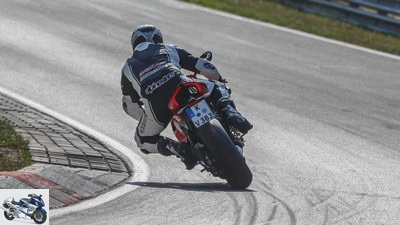
Jorg Kunstle
17/30
"The Ducati has a lot of potential. Really incredibly fast, the device – if it doesn’t break down". Tim Rothig, Nordschleife full throttle guru.
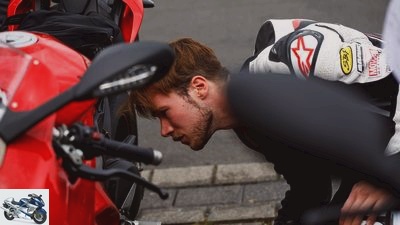
Jorg Kunstle
18/30
Even sad looks don’t help anymore. Shortly before the end of the test, the Panigale V4 S suffered major engine damage.
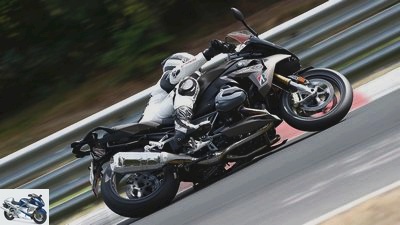
Markus Jahn
19/30
The technical data of the BMW R 1200 S at a glance: two-cylinder boxer engine, four valves / cylinder, 125 hp at 7,750 rpm, 125 Nm at 6,500 rpm, displacement 1170 cm³, weight 246 kg. The basic price is 13,750 euros plus additional costs.
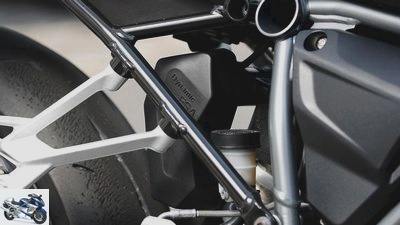
Markus Jahn
20/30
Thanks to Dynamic ESA, the BMW easily cushions the bumps.
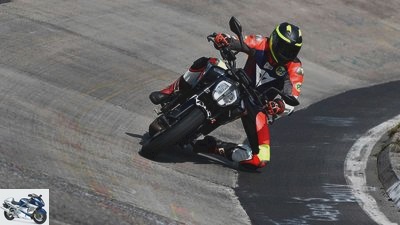
Jorg Kunstle
21/30
The technical data of the KTM 790 Duke at a glance: Two-cylinder in-line engine, four valves / cylinder, 105 hp at 9,000 rpm, 86 Nm at 8,000 rpm, displacement 799 cm³, weight 187 kg. The basic price is 9,790 euros plus additional costs.

Markus Jahn
22/30
On the 790 Duke, the sensors of the shift assistant are not mounted on the shift rod as usual, but rather on the shift shaft, protected from falling.
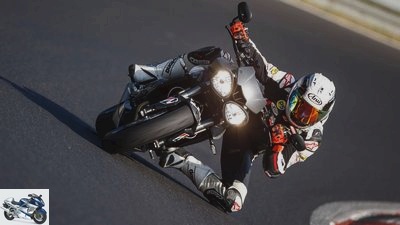
Jorg Kunstle
23/30
The technical data of the Triumph Street Triple 765 RS at a glance: Three-cylinder in-line engine, four valves / cylinder, 123 hp at 11,700 rpm, 77 Nm at 10,800 rpm, displacement 765 cm³, weight 190 kg. The basic price is 11,700 euros plus additional costs.
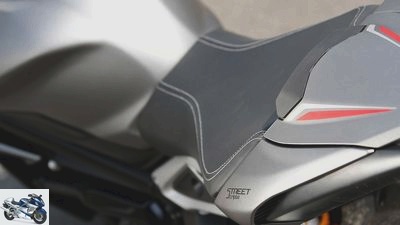
Markus Jahn
24/30
A pinch of Italian aesthetics resonates in the design of the Street Triple 765 RS. With all the sporty genes, the overall package is rounded off by a large portion of driving and seating comfort.
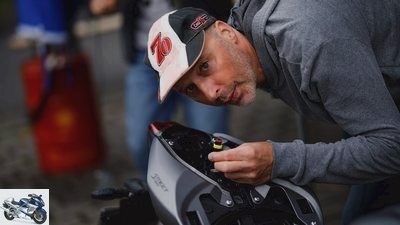
Jorg Kunstle
25/30
To ensure the power supply, the data logger was connected to the on-board network of the respective motorcycle.
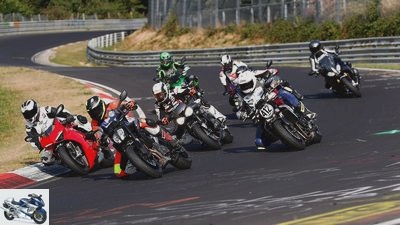
Markus Jahn
26/30
The concept comparison shows the character and peculiarities of the eight machines.
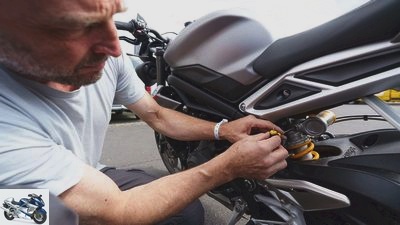
Jorg Kunstle
27/30
PS editor Volkmar Jacob takes care of the chassis settings. They can be used for fast country road driving, even off the Nordschleife.
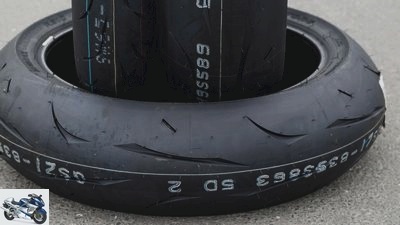
Jorg Kunstle
28/30
To ensure comparability, all motorcycles were fitted with Bridgestone RS10 tires.
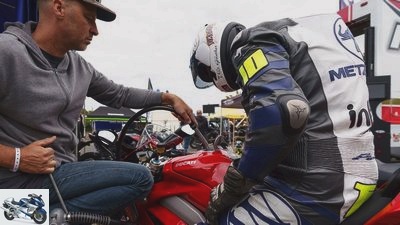
Jorg Kunstle
29/30
Adjust the chassis, count, note down measurements and of course refuel.
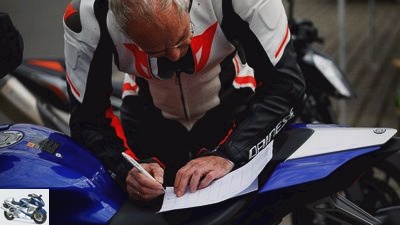
Jorg Kunstle
30/30
Two test days on the Nordschleife also mean a lot of documentation work and paperwork for the crew.
6 naked bikes, 2 athletes and a sports tourer in the test
Concept comparison on the Nordschleife
Content of
With the help of prominent guest testers, PS sent 5 naked bikes, 3 sports motorcycles and a sports touring bike of different displacement classes through the Green Hell to see which ones pass the test on the Nordschleife best.
In the following, the test motorcycles BMW R 1200 RS, Ducati Panigale V4 S, Honda CB 1000 R, Kawasaki Z 900, KTM 790 Duke, Suzuki GSX-S 1000, Triumph will be discussed S.treet Triple 765 RS and Yamaha YZF-R6:
Buy complete article
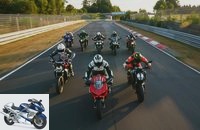
6 naked bikes, 2 athletes and a sports tourer in the test
Concept comparison on the Nordschleife
"They want to make our struts burst?"
Most of them hold back up to the Hatzenbach, but after Hocheichen at the latest they chase us at full throttle towards Quiddelbacher Hohe and after the double right in front of the airfield they squeeze the last bit of power out of the engine. Let us run towards the summit at the Schwedenkreuz with over 200 items, compress us in front of the Aremberg curve, only to then chase us down the Fuchsrohre. With more than 220 km / h we crash into the valley – pure torture.
In the fast downhill left on Metzgesfeld and the slower right on Kallenhard, our front tires get a lot of pressure, so we should precisely indicate the lubrication limit. Likewise on Wehrseifen. But do that when your brakes are glowing, because this Rothig held on to the last during his data recording laps, as if this steep right-left-right crash didn’t even exist.
After the lowest point of the route near Breidscheid, they rush us up the wall at the Exmuhle and almost tear off our throttle cables. As if the electronics hadn’t already regulated how far the throttle valves are open. And when they hang on the handlebars like a tied potato sack and we only get a little kickback because of such bungling, we get pimped.
The brave and knowledgeable fire us through the three left turns after the mine, as if they wanted to press the rear tire off the rim and even the less big heroes then pull so mercilessly that our engines almost explode from the sheer full load. “There’s a lack of power in the kettle”, they say afterwards, while you should see how pitifully slowly they pant up there when they are on their bikes on their own.
Then comes this half soup plate, roughly pieced together from concrete slabs, called a carousel. A steep wall curve that gives you nasty kicks. Do we really have to be driven through this at the highest speed? Do they want to burst our struts? But they are probably just gas sick and think nothing of it if they drag us from one lean angle to the other in the Wippermann and almost tear off our handlebars in the process. Or jump with us into the gorge at the Pflanzgarten as if we weren’t afraid of crashing into the opposite slope.
So if you read the comments of the extremely critical testers about us in the following lines, please appreciate what we brave motorcycles can take for granted.
Yamaha YZF-R6
The Yamaha YZF-R6 is the only 600 super sports bike currently on offer in Germany. In the mixed field of this year’s Nordschleife test specimens, it is the machine with the smallest displacement, but achieves almost the same top performance from 599 cm³ as the largest, the BMW R 1200 RS from 1170 cm³. Consequently, the Supersport Yamaha needs about twice the speed for this, and that says a lot about its performance characteristics.
Even a moderate start is hardly possible below 6,000 rpm and requires long, sensitive clutch grinding. When braking into a curve, it is best to downshift at least two gears in order to keep the four-cylinder in the high-performance range above 10,000, or even better, 12,000 rpm. Then he pulls the Yamaha YZF-R6 up the long and steep full-throttle passage of the boiler with a respectable speed, almost as fast as the much more powerful Suzuki GSX-S 1000. This proves the aerodynamic efficiency of the narrow full fairing and gives an indication of it which considerations may have determined the design of the driver’s position.
Jorg Kunstle
The technical data of the Yamaha YZF-R6: four-cylinder in-line engine, four valves / cylinder, 119 hp at 14,500 / min, 62 Nm at 10,500 / min, displacement 599 cm³, weight 193 kg. The basic price is 13,995 euros plus additional costs.
Because the handlebars are also kept very narrow, the footrests are high and relatively far forward. Folding up and ducking is the order of the day, and in the long run that tends to strain the driver even more than the peak power delivery.
The chassis of the Yamaha YZF-R6 seems a little too stiff, almost brittle, for the numerous undulating passages of the Nordschleife. Although the fork and shock absorber were set to rather gentle compression and firm rebound damping, the R6 trampled slightly on bumps in an inclined position and shifted a few centimeters outwards with a rattle until the tires had regained grip. A tendency that has not been mitigated by the stiff edges of the Bridgestone RS10. As the routine grew, this effect could largely be avoided by a clever choice of lines, and the Yamaha also showed in the better-leveled sections what high cornering speed potential it has.
Nevertheless, the impression remains that it is better off on “normal” modern racetracks, where the surface offers more grip and on racing tires it comes into areas where its stiff chassis with the tightly tuned suspension elements begins to work properly. On the Nordschleife, on the other hand, maximum inclination is seldom driven. In many curves you nestle between the outer and inner curbs with a slight swing of your hip; the ups and downs of the track make the special demands on the chassis. The Yamaha YZF-R6 as an extremely sporty knee and elbow grinder is not optimized for this.
Kawasaki Z 900
The fork and shock absorber shouldn’t be too tight for the Nordschleife, as the Yamaha YZF-R6 has shown. Not too comfortable, however, because they then run the risk of breaking through on pronounced bumps at high speeds and causing uncontrollable chassis reactions.
The skeptical testers had this fear in view of the very pleasing highway set-up of the Kawasaki Z 900, but it turned out to be unfounded. The fork no longer smoothly ironed really rough blows, but the signs of being overwhelmed were always harmless – a brief twitch in the steering after a hilltop, a slight shift of the front wheel in a downhill curve. You always had that well under control with the wide handlebars.
Jorg Kunstle
The technical data of the Kawasaki Z 900: four-cylinder in-line engine, four valves / cylinder, 125 hp at 9,500 rpm, 99 Nm at 7,700 rpm, displacement 948 cm³, weight 212 kg. The basic price is 9,095 euros plus additional costs.
With its tangible increase in torque at around 8,000 rpm, as shown in the diagram, the 948 cm³ four-cylinder of the Kawasaki Z 900 was spirited, easy-turning and smooth-running. On the other hand, the simple double-piston floating calipers demonstrated sufficient capacity during negative acceleration to safely dissolve the kinetic energy into heat.
The only disturbing thing was the seating position on the Kawa, which is two to four centimeters too low, even with the higher of the available upholstery. Since the footrests are mounted high in order to avoid leaning, the knee angle is narrow, even for drivers who are well under 1.80 meters tall. This is not only uncomfortable, but also hinders the hanging-off, which makes the excellent grip of the tires really useful.
The Kawasaki Z 900 and the Suzuki GSX-S 1000 were the only motorcycles that did not have a shift assistant, neither for upshifting nor for downshifting. You may take it as a sign of how spoiled the testers are, but in fact this convenience proves to be very helpful. If you get the opportunity to shift down very late, already in an inclined position, without having to worry about the well-measured engagement of the clutch, you have more capacity for the right speed and line in the corner entrance.
With a higher seat and moderately tightened damping, the inexpensive Kawasaki Z 900 could be optimized for even more enjoyable laps on the Nordschleife with little effort. And if you want to drive even more comfortably, you can pack an accessory automatic gearshift on top.
Suzuki GSX-S 1000
The Nordschleife and the Suzuki GSX-S 1000 have both been under their belt for a few years. While the Nordschleife matured into a legend over time, such a change is less likely with Suzuki’s naked thousand. In the meantime, it would be time for a sharp successor with a finer chassis, sophisticated electronics, but definitely a fresh look. Because at first glance, the GSX-S 1000 doesn’t exactly stand out: it is rather quietly submerged in the roster of the seven other test machines.
Markus Jahn
The technical data of the Suzuki GSX-S 1000: four-cylinder in-line engine, four valves / cylinder, 150 HP at 10,000 / min, 106 Nm at 9,500 / min, displacement 999 cm³, weight 212 kg. The basic price is 12,395 euros plus additional costs.
So more of a follower than a draft horse? Only to a limited extent, because the GSX-S 1000 does quite well on the Nordschleife. At four out of seven measuring points, it rushes through with the second highest speed after the powerful Ducati. Preferably where sheer power counts: at the Schwedenkreuz, at the Vmax measuring point Metzgesfeld, up the kettle and right at the end of the route at the Schwalbenschwanz. Guest tester Ole Bartschat (Champion T-Challenge / Trofeo Italiano 2016/2017) knows most of the north European race tracks like the back of his hand, but the Nordschleife was new to him to this day. The Suzuki makes his first contact with the Green Hell easy for him.
First and foremost, Ole praises the meaty torque of the engine: “Punch in the middle is there, I haven’t got any further up”, laughs the Nordschleife novice. The drive from the old GSX-R 1000 K7 always keeps a lot of pressure ready between 6,000 and 9,000 rpm. As a result, on the ice curve between Brunnchen and Pflanzgarten, for example, it does not play a vital role whether you have engaged second gear or a relaxed third gear. For comparison: The Yamaha YZF-R6 would not get out of the quark here in third gear!
Honda CB 1000 R.
When PS calls for you to bend and push, road racer, Pikes Peak veteran and part-time social media star Thilo Gunther doesn’t hesitate for long: “So many mopeds with high handlebars – I’ll be there!” The seat position of the Honda CB 1000 R fits the tall racing driver straight away. Only the long, fearful nipples on the footrests have to be removed as a precaution! Ergonomically, the Honda differs greatly from the Suzuki or the Kawa, as you sit on the machine rather than deep inside the machine as with the GSX-S 1000 or the Z 900. Because of the upright posture, the overview in the saddle of the Honda is really good. The first driving impression remains positive.
Markus Jahn
The technical data of the Honda CB 1000 R: four-cylinder in-line engine, four valves / cylinder power, 145 hp at 10,500 rpm, 104 Nm at 8,250 rpm, displacement 998 cm³, weight 214 kg. The basic price is 13,290 euros plus additional costs.
When loading the aisles after a long joyful wheelie through the zoo, the Honda CB 1000 R scores with its buttery smooth and precisely switchable transmission. The test machine has installed an automatic gearshift with blipper from the Honda range, which makes it even better. It takes getting used to: If you brake reasonably sportily, the hazard warning lights come on. Strictly speaking, in front of almost each of the 73 bends in the Eifel roller coaster.
A cross comparison of the Honda CB 1000 R with one of the other machines from the test field is most likely with the Suzuki GSX-S 1000. Both are naked Japan thousands with in-line four-cylinders and at least similar power output, whereby the Honda engine feels a bit more spontaneous. On the Nordschleife, the poorly designed center of the Ex-Fireblade drive between 4,000 and almost 8,000 rpm is to be tolerated, because most of the time you move above this speed range.
Compare Honda and Suzuki
But if you want to do the almost 21-kilometer lap on the Nordschleife in a sporty way instead of taking a walk, you miss a direct feeling for the front wheel and more pressure on it. When accelerating over bumps, the front sometimes becomes unintentionally light, shoots up and shows a tendency to nervousness. In particular, the shock absorber does not respond very sensitively and causes the rear to trample when you are sloping over bumps. As a result, the tire has to take on part of the damping, which for guest tester Bartschat in the Kallenhard section caused a spectacularly sliding rear end with a corresponding moment of shock. The cornering speed of the Honda is also limited to the right by the exhaust pipe that hits the ground.
However, the Suzuki engine continues to power strongly in the upper speed range. In addition, the machine is not tilted enough in all sections of the Nordschleife. And although more gently appealing spring elements would upgrade the GSX-S 1000, the chassis does not penetrate even in nasty bumpy sections. When Ole’s speed increased after further laps, the racer complained about a shifting pressure point on the brake. An automatic gearshift would generally look good on the naked bike and increase the fun factor, also off the Nordschleife.
Ducati Panigale V4 S.
To pound a Ducati Panigale V4 S over the Nordschleife as if it had cozy gravel beds or friendly run-off areas – you should only do that if you really want to. After a few blink of an eye, the speed level of the Ducati reaches the disaster area in which one can no longer afford to make mistakes. Not here in the Green Hell. In the event of an emergency, the other machines can still be used casually or initiate a small correction using the brake. This does not work with the V4 Ducati if you hammer over the Schwedenkreuz with a speedometer of 280 km / h: all in. Pray to God that behind the hilltop it goes left at the right angle to Aremberg, and that you don’t turn in a touch too late or it goes right behind the blind corner.
Markus Jahn
The technical data of the Ducati Panigale V4 S: four-cylinder 90-degree V-engine, four valves / cylinder, 214 hp at 13,000 / min, 124 Nm at 10,000 / min, displacement 1103 cm³, weight 201 kg. The basic price is 27,990 euros plus additional costs.
According to GPS, the Ducati manages 262 km / h at Schwedenkreuz. Behind her, the Suzuki came in second fastest at 226 km / h, the slowest (KTM) at 202 km / h. However, the Panigale V4 S only achieved the highest speed at four out of seven measuring points. Under the impression of brute acceleration, Tim slightly misjudged himself before the curve down to Metzgesfeld and up on the Hohe Acht. The Ducati is one thing above all else: highly spectacular! But she does not forgive mistakes.
If you don’t constantly try to exhaust the power of the engine, the stress level drops. Only then do you notice how precisely the Ducati Panigale V4 S steers in and how lightly it mills down the Hatzenbach when guided loosely on the handlebars. We set the damping to “Fixed Custom”, and apart from the jolting ride in the carousel, the chassis takes the pitfalls of the Nordschleife with deeply relaxed equanimity and diligently tells of the grip conditions. Tim isn’t exactly a Ducati friend. With the Panigale V4 S, apart from its complexity, he can think of nothing to criticize.
However, Ducati has to put up with critical questions about durability. Shortly before the end, the V4 S stopped abruptly. A valve seat ring had come loose and was smashed by the piston. Before the engine got stuck, the piston head hammered the valve disc across the intake port. A fragment of the ring blocked the throttle valve, another was lying around in the air filter, a third landed on the neighboring valve, which was also bent. In short: core scrap.
BMW R 1200 S.
Bump iron – the BMW R 1200 RS has truly earned this honorary name. Its semi-active ESA suspension in dynamic mode even handles the rough waves thrown by racing cars so confidently that you can hardly feel them. This is not only comfortable, but also helps the driving dynamics. You can run the BMW with the reassuring awareness that the tires are always in contact with the ground.
Markus Jahn
The technical data of the BMW R 1200 S: two-cylinder boxer engine, four valves / cylinder, 125 hp at 7,750 rpm, 125 Nm at 6,500 rpm, displacement 1170 cm³, weight 246 kg. The basic price is 13,750 euros plus additional costs.
For the relatively heavy bike, the air pressure of the rear tire had to be increased from 1.9 to 2.2 bar. This also reduced the slight agitation around the vertical axis that the BMW R 1200 RS showed in fast passages such as the approach to the Schwedenkreuz. However, none of the eight drivers had increased so much that there was any danger.
Because the new boxer with water cooling is also quite wide and the curbs rise steeply on the Nordschleife, it is advisable not to get too close to the curbs at the apex with the BMW, but apart from that, the sports tourer proves to be a talented high-speed motorcycle. The brakes decelerate with power and stability, and the engine delivers far more torque than any other up to 7,600 rpm. Behind its low-frequency hum that sounds so cozy, it hides a lot of power. The maximum output is already at 7,800 rpm, and at around 8,000 you can easily shift into the next higher gear with the help of the well-functioning shift assistant. Downshifting is also very easy with the smoothly working blipper, and an anti-hopping clutch from FCC supports the difficult phase of hard braking, downshifting and turning in.
The BMW R 1200 S is a fine example of the fact that great sporting talent can also result from the endeavor to make driving at high speed as easy and comfortable as possible for the driver.
KTM 790 Duke
With the 790 Duke, KTM is entering a new era – it is the first motorcycle in the company’s history with a two-cylinder in-line engine. In a conversation that took place rather by chance, chief designer Gerald Kiska praised the compactness, the comparatively low production costs and the favorable power-to-weight ratio of this construction principle.
And indeed, with a full tank of just 187 kilograms, the KTM is the jumping field of the octet. This is not to be taken literally; she never had to jump into the field, but actually didn’t show such a good roadholding as the heavier machines, but often performed small but luckily harmless hops over waves and crests. Not that the 790s were sprung too hard; the shock absorber could even use a harder spring and thus create a few degrees of lean angle. The fork and shock absorber are dampened quite tightly, however, and so the ultimate sensitivity for response is lacking.
Jorg Kunstle
The technical data of the KTM 790 Duke: two-cylinder in-line engine, four valves / cylinder, 105 hp at 9,000 rpm, 86 Nm at 8,000 rpm, displacement 799 cc, weight 187 kg. The basic price is 9,790 euros plus additional costs.
As in everyday driving, the engine also proves to be a real fun maker on the Nordschleife. It reacts spontaneously to commands on the throttle, and thanks to the low centrifugal masses, the engine revs up sharply when accelerating. The downsides of this lively temperament, for example pronounced constant jerking, do not play a role on the Nordschleife. There, however, the in-line twin-cylinder is less able to cover up the fact that it pushes the lowest peak performance of the eight motorcycles than in everyday use. This explains why the 790 Duke is slower wherever sheer performance plays a decisive role.
When things get bendy, she’s full of music, and once again an electronic shift assistant that works in both directions helps. KTM transmissions can traditionally be shifted easily, but with the blipper you can literally step down the gears in the last few meters before the apex of the curve and thus take a lot of momentum into the curve.
In view of the pleasing properties of the engine and chassis concept, we ask for an RC 790 with narrow handlebars, full fairing and a few more horsepower. It would be a wonderful Nordschleife motorcycle.
Triumph Street Triple 765 RS
If you know the Nordschleife just a touch less well than our pacemaker and measurement driver Tim Rothig, you don’t need 200 hp or more on this very selective slope. You couldn’t implement it anyway. Strictly speaking, you don’t need a single horsepower more than the nominal 123 of the Triumph Street Triple 765 RS to firstly be fast and secondly to have a lot of fun. This applies even to someone with a unique track knowledge: Master Rothig himself wears a blissful smile on his face when he returns from his stint with the Streety. “Wow, that’s really good,” he says, emphatically factual. Anyone who knows Tim knows that on the same day with some probability he will not utter another sentence that resonates with greater praise than this one.
Jorg Kunstle
The technical data of the Triumph Street Triple 765 RS: three-cylinder in-line engine, four valves / cylinder, 123 hp at 11,700 rpm, 77 Nm at 10,800 rpm, displacement 765 cm³, weight 190 kg. The basic price is 11,700 euros plus additional costs.
The Triumph’s recipe for success lies in its phenomenal overall package. It is comfortable, but narrowly drawn and light. It drives precisely and easily, but is still reassuringly stable. Of the naked bikes in the test, it delivers the best feel for the front wheel. It also has a very formidable brake, and its chassis responds well both front and rear. In this way, the driver learns a lot about the condition of the asphalt and the level of grip and has confidence in the machine. This helps, for example, on the ascent to the Ex-Muhle or in the Caracciola carousel, to turn confidently and (in the second case) to beat the vibrating plates fearlessly. Thilo is especially impressed by the sound of the triple: “It hisses so nicely from the airbox, you just want to go full throttle!” Naturally, the full throttle percentage is highest on the KTM 790 Duke, because it also has the lowest peak performance. Right after that, however, is the Street Triple. It has so much power that on the one hand you can squeeze it out nicely and on the other hand you are still able to think clearly and mentally prepare yourself for the approaching curves. Only the retro-look mirrors offer serious potential for improvement. Because if you dismantle it, your hands would have a little more space on the handlebars!
Strictly speaking, the Nordschleife is a country road with no speed limit that you can only drive in one direction. Its length of 20.8 kilometers and the special location and topography between an eleven degree gradient and 17 degree gradient make up part of its specialty. The second part of their fascination is made up of the many secluded bends, bumps and changing grip conditions – all in the midst of the lush green of the densely forested Eifel.
If you are driving here for the first time, you should work your way slowly. Anyone who has repeatedly ridden the Eifel roller coaster and is able to circle the course at racing speed should occasionally remind themselves not to lose respect for the track. Note: little to no fall space.
Affirmation of love for the Nordschleife
However, this comparison of concepts proves that you don’t need 200 hp (or even more) on the Nordschleife to be fast and have fun. Feedback, precision and predictability are the virtues that push driving fun on the Nordschleife the most. Intentionally, there is no scoring in this test. Based on selected data recording measurement points and the opinions of the various testers, we do not want to name a winner or even a loser. Rather, it’s about working out the character and peculiarities of each of the eight machines on a route that is unique worldwide. Since 1927.
Conclusion
Tim Rothig: At first I was skeptical about the choice of test bikes. Up until now I thought you needed at least 150 hp on the Nordschleife. That is probably not the case, as the KTM 790 Duke or the Triumph Street Triple 765 RS prove. With the KTM, almost everything fits, only the shock absorber is a bit slack and the height of the handlebars is excessive. But otherwise, for the money, a great motorcycle! The best compromise is probably the Street Triple. A great mix of everything: nice chassis, sporty seating position, good front wheel feel. It could possibly use a little more top performance. Whereby: As long as it is enough to cushion Thilo on the Panigale, everything is actually fine. By the way, I was positively surprised by the Panigale V4 S, the device is really good fun. Ducatis always pinch me a bit, but I can even sit on this one. And we don’t need to discuss engine performance; it leaves us speechless.
Thilo Gunther: I am a naked bike fan and was therefore happy to see all the machines with high handlebars. For example, I wasn’t too keen on the Panigale because the speed level with such a club is beyond good and bad and mistakes are almost inevitable. I once counted: With the BMW I drive at full throttle for 20 seconds in the boiler, with the Panigale not a single one. So what’s that supposed to be? I liked the Suzuki a lot: enough punch, stable chassis. Unfortunately, it doesn’t have a gearshift, which should be standard by now. What I generally miss with the Japanese machines is that you cannot switch off all of the electronic helpers. It has to be like the Triumph – it’s my favorite because everything is just right, from handling to sound.
Ole Bartschat: My first impression of the Nordschleife: exaggerated! You drive out and at the beginning you just don’t know where to go. Closing curves, opening curves, downhill, uphill … really awesome! Later I was able to drive fast and relaxed with the Street Triple, the Duke and the GSX-S 1000. I also really like the Panigale because the seating position fits exactly. And in terms of performance, the Ducati is of course awesome. It just pushes anywhere: bottom, middle, top – it doesn’t matter! The Honda gave me less security. In my opinion, the rear is underdamped and the front wheel is too nervous. To do this, it touches down in an inclined position, and then it moved me to the side. The limit is easily reached with her.
Ralf Schneider: After an eight-year absence, the re-encounter with the Nordschleife hit me like a bang. Anyone who has driven this route even once in their life describes it as something very extraordinary. But never before have I felt this peculiarity as strongly as during this test. I took every opportunity to ride one of the eight motorcycles, and the fun wasn’t the main factor. I am driven by the challenge of rediscovering this special route with the necessary mix of boldness and respect, discipline and play instinct, precision and looseness. I would love to keep working on it, and if I can choose, I would like to do it with the Triumph Street Triple.
Stefan Gluck: The BMW R 1200 RS is made for Nordschleife rookies like me. First of all, I like the good overview of the game thanks to the not too sporty seating position. Second, the boxer delivers plenty of punch to hit the corners well, but not too much to scare you. Because if you have so much performance that you don’t use it out of sheer awe, then in the end it doesn’t help either. The BMW brakes are similar to performance. Responds well and does what it should – you can devote all your attention to the route. The R 1200 RS is actually a win-win bike. If you are passed through to the rear quickly, it says pityingly: “With the boxer is no longer possible.” But if it takes longer to pass it through, the driver earns praise and recognition in the sense of “he lets it fly!”
Tobias Munchinger: When I was on the Nordschleife for the first time, with the best will in the world I couldn’t imagine driving a fast lap without a tourist guide right in front of me. I think that must have been five years. Except for once, I’ve been back here every year since then and have played a few laps. All in all, I would have to come to maybe 60 or 70 laps, cautiously. And lo and behold: I now know my way around! I don’t know the third first name of each bump and the degree of marriage to the next as well as Tim. But good things take time, especially here on the Nordschleife. When Tim is 90 and walks on the rollator, I might challenge him to a race through “Green Hell”!
Georg Jelicic: It’s been 29 years since the Nordschleife virus caught me. It was like that back then: met up with friends in the evening and then drove to the Nordschleife by axle. Up in the Eifel we stayed at Mother Rieder’s and the next day we waited punctually at the T 13, in order to then have the nice gentleman with a peaked cap and rubber boots snap off the ten card. Sometimes there was even one or the other round for free! After that, the goal was to come here at least once a year. Admittedly, it didn’t always work out. But the friendly colleagues from PS have made it possible for me many times. It’s nice here and I hope that I can come back soon.
Volkmar Jacob: Unfortunately, this year I was only left with the role of photo driver and paddock daddy at the big Nordschleife test. With laps it was just nothing. But if you have to fly to Japan shortly before the editorial deadline to present the new Kawasaki ZX-10R, you have no choice but to leave the paperwork to the common cavalry, take it back and sit on a plane for hours. Hey guys, that’s life! But this is only marginally and back to the actual topic: I really liked the KTM 790 Duke on the Nordschleife when I took photos. There is not an ounce too much, it has perfectly functioning electronics and a playful, funky driving behavior. The engine is also cream, and the ratio of purchase price to driving fun is impressive with the Duke! And who knows, maybe a stronger R version will come soon? After all, there is always more steam!
Data recording
If you are interested in the detailed evaluation of the data recording of all eight motorcycles, you can download the 29-page PDF, see below.
Related articles
-
fact Concept comparison Honda CBR 1100 XX Kawasaki ZX-12 R Suzuki GSX-R 1000 Suzuki GSX 1400 Yamaha FZS 1000 Fazer Yamaha FJR 1300 Six bombs The six most…
-
Concept comparison sport enduros
Concept comparison sport enduros heaven and hell joy or sorrow ?? Often a question of displacement for sport enduro bikes. But how many cm3 do you need in hard …
-
Comparison test: Motocross concept comparison
Jahn comparison test: Motocross Suzuki, KTM and Honda Motocross concept comparison: 250, 350 and 450 cm³ With the 350 SX-F, KTM wants the performance of a …
-
Concept comparison of power bikes from BMW, KTM, Suzuki and Kawasaki
fact 46 photos fact 1/46 At first glance, a fight between a hot naked, a super athlete, a big enduro and an aging launcher may seem rather out of place….
-
Jahn Concept Comparison: Enduros Between Hard Enduro and Motorhome The boundaries between hard enduro and motorhome are blurring more and more. MOTORCYCLE…
-
Concept comparison sports tourer
Art 12 pictures BMW 1/12 driving fun in BMW style. BMW 2/12 eye-catcher: the cladding in lava orange metallic. BMW 3/12 With an engine power of …
-
Concept comparison super athlete
fact Concept comparison super athlete The first time colleague Ebner, a staunch Harley fanatic, is in love ?? in super athletes. He just doesn’t know that yet …
-
Concept comparison super sports car: Aprilia RS 250-Kawasaki ZX 6R-Yamaha YZF R1
Concept comparison of the super sports car: Aprilia RS 250 / Kawasaki ZX 6R / Yamaha YZF R1 Bet that … … power is irreplaceable and the lightweight 250cc …
-
Concept comparison: enduro fun bike
Artist Concept comparison: enduro / fun bike Wrong world Austrian two-cylinder engines stir up the naked bike scene, birds need a flu shot, and now a…
-
Photos: fact Concept comparison 100 hp 100 HP – The whole truth Early material for endless discussions: 100 hp. Today completely normal ?? but no less…